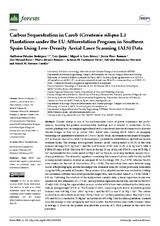Mostrar el registro sencillo del ítem
Carbon Sequestration in Carob (Ceratonia siliqua L.) Plantations under the EU Afforestation Program in Southern Spain Using Low-Density Aerial Laser Scanning (ALS) Data
| dc.contributor.author | Palacios Rodríguez, Guillermo | |
| dc.contributor.author | Quinto, Luis | |
| dc.contributor.author | Lara-Gómez, Miguel | |
| dc.contributor.author | Pérez Romero, Javier | |
| dc.contributor.author | Recio, José Manuel | |
| dc.contributor.author | Álvarez-Romero, Marta | |
| dc.contributor.author | Cachinero-Vivar, Antonio M. | |
| dc.contributor.author | Hernández-Navarro, Salvador | |
| dc.contributor.author | Navarro Cerrillo, Rafael M. | |
| dc.date.accessioned | 2022-02-11T08:04:46Z | |
| dc.date.available | 2022-02-11T08:04:46Z | |
| dc.date.issued | 2022 | |
| dc.identifier.uri | http://hdl.handle.net/10396/22452 | |
| dc.description.abstract | Climate change is one of the environmental issues of global dominance and public opinion, becoming the greatest environmental challenge and of interest to researchers. In this context, planting trees on marginal agricultural land is considered a favourable measure to alleviate climate change, as they act as carbon sinks. Aerial laser scanning (ALS) data is an emerging technology for quantitative measures of C stocks. In this study, an estimation was made of the gains of C in biomass and soil in carob (Ceratonia siliqua L.) plantations established on agricultural land in southern Spain. The average above-ground biomass (AGB) corresponded to 85.5% of the total biomass (average 34.01 kg tree−1), and the root biomass (BGB) was 14.5% (6.96 kg tree−1), with a BGB/AGB ratio of 0.20. The total SOC stock in the top 20 cm of the soil (SOC-S20) was 60.70 Mg C ha−1 underneath the tree crown and 43.63 Mg C ha−1 on the non-cover (implantation) area for the C. siliqua plantations. The allometric equations correlating the biomass fractions with the dbh and Ht as independent variables showed an adequate fit for the foliage (Wf, R2adj = 0.70), whereas the fits were weaker for the rest of the fractions (R2adj < 0.60). The individual trees were detected using colour orthophotography and the tree height was estimated from 140 crowns previously delineated using the 95th percentile ALS-metric. The precision of the adjusted models was verified by plotting the correlation between the LiDAR-predicted height (HL) and the field data (R2adj = 0.80; RMSE = 0.53 m). Following the selection of the independent variable data, a linear regression model was selected for dbh estimation (R2adj = 0.64), and a potential regression model was selected for the SOC (R2adj = 0.81). Using the segmentation process, a total of 8324 trees were outlined in the study area, with an average height of 3.81 m. The biomass C stock, comprising both above- and below-ground biomass, was 4.30 Mg C ha−1 (50.67 kg tree−1), and the SOC20-S was 37.45 Mg C ha−1. The carbon accumulation rate in the biomass was 1.94 kg C tree−1 yr−1 for the plantation period. The total C stock (W-S and SOC20-S) reached 41.75 Mg ha−1 and a total of 4,091.5 Mg C for the whole plantation. Gleaned from the synergy of tree cartography and these models, the distribution maps with foreseen values of average C stocks in the planted area illustrate a mosaic of C stock patterns in the carob tree plantation. | es_ES |
| dc.format.mimetype | application/pdf | es_ES |
| dc.language.iso | eng | es_ES |
| dc.publisher | MDPI | es_ES |
| dc.rights | https://creativecommons.org/licenses/by/4.0/ | es_ES |
| dc.source | Forests 13(2), 285 (2022) | es_ES |
| dc.subject | Forest plantations | es_ES |
| dc.subject | Agricultural land | es_ES |
| dc.subject | Biomass | es_ES |
| dc.subject | Soil carbon sequestration | es_ES |
| dc.subject | Allometric equations | es_ES |
| dc.subject | LiDAR | es_ES |
| dc.title | Carbon Sequestration in Carob (Ceratonia siliqua L.) Plantations under the EU Afforestation Program in Southern Spain Using Low-Density Aerial Laser Scanning (ALS) Data | es_ES |
| dc.type | info:eu-repo/semantics/article | es_ES |
| dc.relation.publisherversion | https://doi.org/10.3390/f13020285 | es_ES |
| dc.relation.projectID | Gobierno de España. CGL2017-86161-R | es_ES |
| dc.rights.accessRights | info:eu-repo/semantics/openAccess | es_ES |

